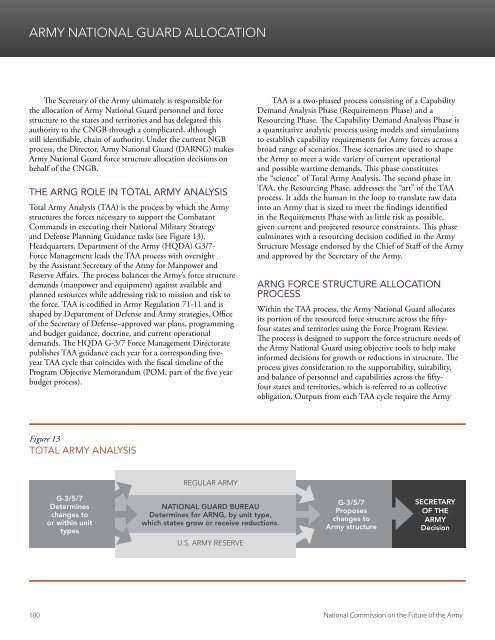THE FUTURE OF THE ARMY
NCFA_Full%20Final%20Report_0
NCFA_Full%20Final%20Report_0
You also want an ePaper? Increase the reach of your titles
YUMPU automatically turns print PDFs into web optimized ePapers that Google loves.
<strong>ARMY</strong> NATIONAL GUARD ALLOCATION<br />
The Secretary of the Army ultimately is responsible for<br />
the allocation of Army National Guard personnel and force<br />
structure to the states and territories and has delegated this<br />
authority to the CNGB through a complicated, although<br />
still identifiable, chain of authority. Under the current NGB<br />
process, the Director, Army National Guard (DARNG) makes<br />
Army National Guard force structure allocation decisions on<br />
behalf of the CNGB.<br />
<strong>THE</strong> ARNG ROLE IN TOTAL <strong>ARMY</strong> ANALYSIS<br />
Total Army Analysis (TAA) is the process by which the Army<br />
structures the forces necessary to support the Combatant<br />
Commands in executing their National Military Strategy<br />
and Defense Planning Guidance tasks (see Figure 13).<br />
Headquarters, Department of the Army (HQDA) G3/7-<br />
Force Management leads the TAA process with oversight<br />
by the Assistant Secretary of the Army for Manpower and<br />
Reserve Affairs. The process balances the Army’s force structure<br />
demands (manpower and equipment) against available and<br />
planned resources while addressing risk to mission and risk to<br />
the force. TAA is codified in Army Regulation 71-11 and is<br />
shaped by Department of Defense and Army strategies, Office<br />
of the Secretary of Defense–approved war plans, programming<br />
and budget guidance, doctrine, and current operational<br />
demands. The HQDA G-3/7 Force Management Directorate<br />
publishes TAA guidance each year for a corresponding fiveyear<br />
TAA cycle that coincides with the fiscal timeline of the<br />
Program Objective Memorandum (POM, part of the five year<br />
budget process).<br />
TAA is a two-phased process consisting of a Capability<br />
Demand Analysis Phase (Requirements Phase) and a<br />
Resourcing Phase. The Capability Demand Analysis Phase is<br />
a quantitative analytic process using models and simulations<br />
to establish capability requirements for Army forces across a<br />
broad range of scenarios. These scenarios are used to shape<br />
the Army to meet a wide variety of current operational<br />
and possible wartime demands. This phase constitutes<br />
the “science” of Total Army Analysis. The second phase in<br />
TAA, the Resourcing Phase, addresses the “art” of the TAA<br />
process. It adds the human in the loop to translate raw data<br />
into an Army that is sized to meet the findings identified<br />
in the Requirements Phase with as little risk as possible,<br />
given current and projected resource constraints. This phase<br />
culminates with a resourcing decision codified in the Army<br />
Structure Message endorsed by the Chief of Staff of the Army<br />
and approved by the Secretary of the Army.<br />
ARNG FORCE STRUCTURE ALLOCATION<br />
PROCESS<br />
Within the TAA process, the Army National Guard allocates<br />
its portion of the resourced force structure across the fiftyfour<br />
states and territories using the Force Program Review.<br />
The process is designed to support the force structure needs of<br />
the Army National Guard using objective tools to help make<br />
informed decisions for growth or reductions in structure. The<br />
process gives consideration to the supportability, suitability,<br />
and balance of personnel and capabilities across the fiftyfour<br />
states and territories, which is referred to as collective<br />
obligation. Outputs from each TAA cycle require the Army<br />
Figure 13<br />
TOTAL <strong>ARMY</strong> ANALYSIS<br />
REGULAR <strong>ARMY</strong><br />
G-3/5/7<br />
Determines<br />
changes to<br />
or within unit<br />
types<br />
NATIONAL GUARD BUREAU<br />
Determines for ARNG, by unit type,<br />
which states grow or receive reductions.<br />
G-3/5/7<br />
Proposes<br />
changes to<br />
Army structure<br />
SECRETARY<br />
<strong>OF</strong> <strong>THE</strong><br />
<strong>ARMY</strong><br />
Decision<br />
U.S. <strong>ARMY</strong> RESERVE<br />
100 National Commission on the Future of the Army


